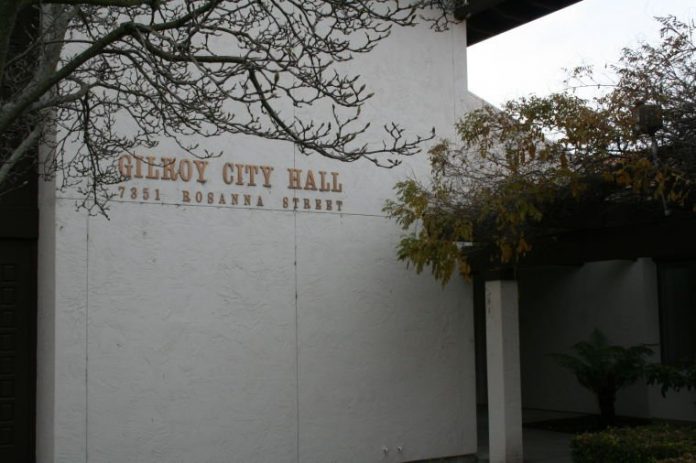City Council is considering taking a closer look at its 300-page biennial budget that includes the addition of seven new jobs and a $55.8 million expenditure for Gilroy police and fire departments, something Mayor Pro Tempore Perry Woodward wants to scale back.
Gilroy’s proposed two-year budget for public safety rounds out to $38.3 million for police and $17.5 million for fire. That represents a collective $5 million increase from fiscal year 2012-13.
While some of the police and fire costs are defrayed by $2 million generated by the GPD and GFD through grants, parking fines and other miscellaneous revenues, the addition of new police and firefighter positions prompted Woodward to get heated during an April 24 budget meeting over what he views as routinely high public safety spending.
“There are other things like Parks and Recreation that probably deserve a little more funding than they’re getting,” he pointed out. “We need to task staff with creating a road map that gets us there.”
Woodward reiterated that he doesn’t want to cut police jobs; rather, he wants Council to step up to its responsibility of getting the best deal for the taxpayers and see if there are more ways the department can spend less money and still operate effectively.
“We need to find the most efficient way,” he insisted. “We have consciously decided to not do that, which to me is unacceptable.”
If Council continues to “turn a blind eye” to what Woodward views as over-spending on public safety, “then we are failing,” he added.
Council members say they are more than open to studying ways to cut back or save money on public safety funding, although Mayor Don Gage reminded everyone of the inherent danger of trying to protect Gilroyans on a shoestring budget.
“The question that is being asked here is an extremely difficult question,” observed the mayor. “It has a lot of very complicated parts.”
Dealing with the fluid nature of social issues and crime that GPD encounters on a daily basis isn’t a simple process, he added.
“If you have a significant homeless problem and you have a significant gang problem, than you better have enough people to suppress it,” Gage asserted. “Otherwise, the community itself will go bananas and be screaming for scalps.”
The balanced budget – buoyed by resurgent sales tax growth that is on course to match the halcyon days of $14.5 million in 2007 by fiscal year 2015 – includes several personnel additions.
The total combined proposed budget for 2014 and 2015 is $241.9 million. That includes a general fund budget of $42.3 million in 2014 – an increase of $1.9 million from 2013 – and $43 million in 2015.
In the next two years, the City will hire a planner and building inspector for the Community Development Department; an engineer and engineering technician for the Public Works Department and a resources analyst for the Human Resources/Risk Management Department. GPD will also gain two new officers in addition to changing one of its part-time crime analysts to full time. The GFD will have three firefighters funded from the general fund when one of its federal grants expires in June 2015.
Gilroy, like other cities in California over the past 25 years, has a budget that includes a fully loaded public safety expenditure of around 80 percent according to Haglund.
“Are we making improvements on that? Do we have a plan on bringing that number down?” Woodward asked during the meeting. “That’s what I was hoping to hear tonight.”
As a 10-second moment of stunned silence enveloped the dais, Haglund steeled himself to deal with the switch in atmospheres from informational to confrontational.
First of all, Haglund explained, recent changes to the City’s Public Employee’s Retirement System have been implemented to assist with cost reduction by making all employees pay their own portion of retirement costs.
Regardless, public safety is “still going to be 78 to 80 percent” of the City’s expenditures in this particular budget, Haglund reasoned, because there isn’t enough time in the 60 days before the budget is adopted to conduct a thorough cost analysis.
That explanation did little to cool Woodward, who launched into a dialogue with Council members about how the City could rein in public safety spending.
Gilroy’s sales tax revenues have rebounded 19 percent since 2011 and are close to the $14.5 million they were in 2007, he pointed out.
Since the Great Recession of 2007, the City has slashed a total of $13 million from its operating expenses citywide and eliminated or laid people off from a total of 71 jobs spread across all of the City departments.
In 2014, including the seven new hires, the City will employ 245 staff – still well below its total of 298 for 2008.
During the budget meeting, Councilman Peter Leroe-Muñoz took Woodward’s call for cost effectiveness to heart.
“Can we salvage anything from the earlier study?” he asked.
Leroe-Muñoz was referring to the Palo Alto-based Matrix Consulting Group that in 2007 was commissioned to do a $55,000 study examining GPD’s deployment and staffing model.
“We really used the data in the model,” Haglund explained. “We made specific arrests.”
The City may have taken initiative to police more effectively, Woodward acknowledged, but he wants to see even more initiative to budget effectively.
He requested another study that examines how some of the fat, if there is any, can be trimmed from GPD. If Council decides to move forward with the new study, it would be conducted by City staff and compare Gilroy’s methods in tackling public safety issues to those employed by other communities – San Jose’s successful suppression model for gangs was one example touted at the meeting – to see if there are cheaper ways to get the job done.
The GFD’s $17.5 million two-year budget, for example, merits more scrutiny according to Woodward since there are a wide variety of options open to the City, such as amalgamating with the Morgan Hill Fire Department or contracting out to CalFire.
“Fire is actually a small percentage of what they actually do,” Woodward opined. “I think there’s some significant cost savings to be achieved.”
Scaling back on GFD expenses was previously on the table in 2011, when Council voted 6-1 to not outsource any services to outside contractors. Woodward cast the lone dissenting vote on that occasion.
Councilwoman Cat Tucker is completely opposed to the idea of restructuring GFD and bringing in cheaper options where possible, even if it would mean more money for the arts and other community programs.
“I’m not willing to outsource the Fire,” Tucker vowed.
Council’s budget discussion also comes at a time when Police Chief Denise Turner is drawing attention to Gilroy’s homeless and transient problems that are draining GPD’s resources.
Still, “I think it’s healthy to have staffing studies periodically. GPD would certainly embrace it,” said Turner. “We’ll work closely with Council and staff if Council approves funding for a study.”
It has only been a matter of weeks, for that matter, since Gage faced a barrage of community member demands for increased levels of police personnel on the streets following the gang-related slaying of 30-year-old Jesse Emmanuel Silos.
The Dispatch was unable to reach Fire Chief Alan Anderson before the paper went to press, but spoke with him Friday morning. Echoing Turner, Anderson welcomed any studies about how to make GFD as cost effective as possible.
“We want to be transparent,” Anderson said. “We want to be good stewards of the taxpayers dollars.”
“If there are initiatives out there, we want to know about them,” he added.
-$38.3 million: Police
-$17.5 million: Fire
-$8.3 million: Public Works
-$5.6 million: Community Development
-$3.9 million: Recreation















